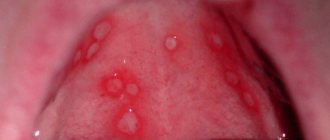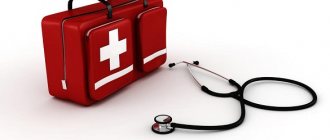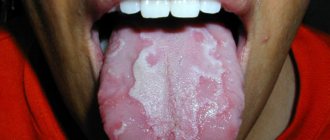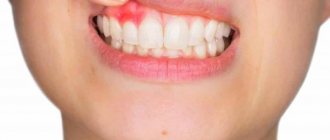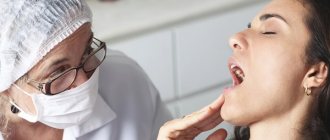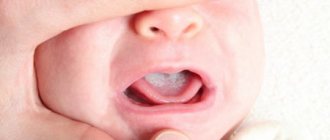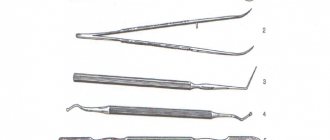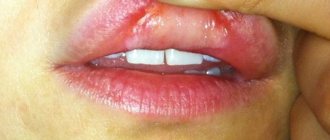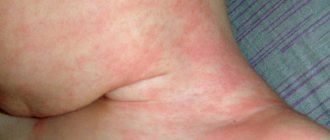Local diseases
The cause of white rashes is stomatitis, which manifests itself in different forms:
- Aphthous - the cause of its appearance has not been identified; it occurs in acute, chronic and recurrent forms. The disease is characterized by the appearance of many aphthae (ulcers) of irregular shape, leading to difficulties in eating. Healing is long and sometimes lasts several months.
- Candidiasis - most often found in newborns. The white pimples in the mouth gradually merge, and the entire cavity becomes covered with a whitish coating.
- Herpetic - unlike previous forms, the sores are pinkish or red in color and have a watery structure. In addition to the oral cavity, the lips are also affected. It occurs in children from one and a half to three years old. The mild form can be treated at home, while the severe form can be treated in a hospital.
- Allergic – provoked by allergens: plant pollen, household dust, animal hair, etc. By removing the source of the allergy, stomatitis stops.
- Bacterial – develops due to the penetration of pathogenic microflora (staphylococci, streptococci) into existing wounds in the oral cavity.
Injuries
White pimples in a child’s mouth can be caused by various injuries:
- Strong bite of the tongue with teeth, which provoked an inflammatory process and, as a result, the appearance of white ulcers.
- Damage to the mucous membrane caused by hard bristles during oral hygiene.
- Injury from sharp edges of teeth due to violations committed during the installation of filling material.
- Incorrectly selected braces.
- Injuries caused during dental treatment due to careless handling of dental instruments.
Irritation caused by food
Pimples on the roof of your mouth can be caused by irritation after eating something too hot or spicy. Pimples on the inside of your mouth can also be caused by a burning sensation caused by eating overly spicy, salty or sour foods. So make sure that the temperature of your food is normal and that the regular food you eat you consume does not cause irritation in the form of a pimple after some time. Especially in a child, hot food can cause pimples on the upper palate of the mouth.
We invite you to read: Gums become inflamed after dental treatment - causes and first aid
White and red pimples on the roof of the mouth are still not a permanent form of acne; if they appear again and again, then they can be symptoms of even more severe diseases such as oral cancer or symptoms of herpes.
Systemic pathologies
What causes white pimples in a child's mouth? The following diseases can trigger their appearance:
- Pulmonary tuberculosis - affects the mucous membrane of the oral cavity. Sores of a loose structure with uneven edges form on it.
- Syphilis – boils may appear in the oral cavity.
- Necrotizing gingivostomatitis - ulcers appear on the mucous layer of the oral cavity, which are covered with a greenish coating.
- HIV infection - the lesion affects the gums.
In addition, the following pathologies cause the formation of pimples in a child’s mouth:
- dysbacteriosis;
- atonic colitis;
- heart failure in the stage of decompensation;
- hypothyroidism;
- diabetes mellitus.
Complex of causes and nature of rashes
The causes of a rash in the mouth and pimples around it include completely different diseases, the most common being:
- inflammatory dental diseases (stomatitis, candidiasis, etc.);
- infections (scarlet fever, measles, herpes, tonsillitis, syphilis, HIV, fungal);
- autoimmune lesions (systemic lupus erythematosus);
- neoplasms (benign/malignant);
- allergic reactions.
Stomatitis is one of the main reasons that causes a rash in the mouth and ulcers around the mouth in a child:
Rashes can be of different types. They can occur both on altered skin (the so-called primary elements) and as a result of the evolution of the primary rash (secondary elements). Primary elements include: vesicles, pustules, blisters, spots, nodules in the mouth, and secondary elements include: ulcers, scales, cracks.
Depending on the nature of the rash on the oral mucosa, its causes differ:
- Bubbles . Located in the epidermis or under it, the cavity is filled with serous (light) contents. Often found with herpes, chickenpox, and pemphigus.
- Pustules can be deep or superficial, depending on their location in the skin. The cavity of the abscess is filled with turbid contents. Occurs with folliculitis (superficial pustules), boils, carbuncles (deep).
- Blisters do not have a cavity. They exist for a short period of time (minutes, hours). More often observed in allergic reactions: insect bites, urticaria. Blisters are accompanied by a subjective sensation of itching.
- Spots are changes in skin color. Depending on the cause, vascular (inflammatory and non-inflammatory) and pigmentary types are distinguished.
- The nodules do not have a cavity and are located under the epidermis. They usually disappear without a trace. In some diseases, nodules grow and merge to form plaques (candidiasis).
- Ulcers are formed during the evolution of vesicles and pustules. They can be observed in severe cases of chickenpox, purulent skin infections, and systemic lupus erythematosus.
- Scales are a keratinized layer that is rejected. Clinically manifested by peeling.
Rash in children and adults usually has a variety of causes.
"Adult" reasons
In particular, pimples in the mouth (on the tongue, palate, cheeks) and around the mouth on the lips can be a symptom of leukoplakia (which is a precancerous disease).
As a rule, leukoplakia does not cause any sensations and is discovered by chance. For example, at a dentist appointment. The causes of this precancerous condition are smoking, frequent mechanical trauma to the oral mucosa, and unfavorable environmental and work environment factors.
Also, the causes of rashes on the mucous membranes can be:
- fungal infections (candidiasis);
- SLE (systemic lupus erythematosus) is more common in young women 15-35 years old;
- immunodeficiency (HIV infection) - against the background of severe insufficiency of the immune system, various pustular lesions occur, which are extremely difficult to treat with standard methods;
- specific infectious diseases (syphilis);
- allergic reactions (urticaria) – blisters appear in large numbers;
- Malignant neoplasms usually take the form of a long-term non-healing ulcer.
Read also: Bloody lump in the mouth
"Children's Reasons"
In a child, pimples in and around the mouth can occur for various reasons:
Measles is a very unpleasant disease
- Childhood infections (measles - white pimples in the mouth on the surface of the cheeks and tongue, scarlet fever - a profuse rash of a pinpoint nature, diphtheria - films form in the tonsil area, which, after removal, leave behind ulcers).
- Allergies (food, drug, etc.). Children under one year of age suffer from allergies most often when a new type of complementary food is introduced or when artificial feeding is incorrectly selected.
- Inflammatory process (violation of hygiene rules). This reason is very common, especially if the child attends kindergarten. Stomatitis (inflammation of the oral cavity) causes noticeable changes in the child's behavior. He becomes inattentive, whiny, irritable, and may even refuse to eat.
Some treatment features
Therapy should be aimed at eliminating the root cause and alleviating the condition of the little patient. In case of mechanical damage to the oral mucosa, the wound surface is treated, having previously removed the foreign object. If chronic pathologies are the cause of white pimples in a child’s mouth, comprehensive treatment is recommended using medications from different pharmacological groups:
- "Arbidol", "Acyclovir" - has an antiviral and anti-inflammatory effect.
- Antiseptics are used for irrigation and rinsing.
- Antipyretics – to relieve fever.
- Vitamin complexes - to strengthen the immune system.
- Antibiotics do an excellent job of killing pathogens.
A prerequisite for successful treatment is maintaining oral hygiene and drinking plenty of fluids.
Treatment methods
An independent course of treatment should not be prescribed. Many people look at the photo and begin to rinse their mouths with decoctions, tinctures and traditional medicine. Only an experienced doctor can accurately diagnose a white pimple in the mouth and determine the cause of its appearance.
If the palate, cheeks and tongue are covered with a transparent coating with a white tint, rinsing is initially prescribed:
- a decoction of oak bark, celandine, yarrow, nettle and birch;
- chlorophyllipt solution;
- boiled water with the addition of oil essence of sea buckthorn berries.
If a pimple in the mouth on the cheek causes unbearable pain or frequent itching, a specialist may prescribe an analgesic drug. It should be taken according to a prescription, taking into account precautions and existing contraindications. Treatment for neoplasms on the mucous membrane should be comprehensive. Doctors use:
- medications;
- antimicrobial and antifungal ointments;
- lotions that soothe inflammation;
- immune therapy aimed at strengthening the body's protective functions.
The use of toothpastes and personal hygiene products containing alcohol and lauryl sulfate in the combined composition is temporarily excluded. The molecules of these substances deform the transparent layer of the ulcers, causing them to increase in size up to three times .
Causes of thrush in newborns
This fungal disease often occurs in weak and premature babies and affects the mucous membranes of the tongue and oral cavity. He can become infected from his mother or another person who has been in contact with him. The pathogen enters the body of a small person through a pacifier or other objects that the baby puts into the mouth. Infection during the period of delivery occurs if the mother has pathogenic species of fungi in the vagina. Frequent regurgitation also provokes the occurrence of thrush in the mouth of a baby, since during this process stomach contents accumulate in the oral cavity, which has an acidic environment, which is a fertile environment for the proliferation of fungi. Long-term antibacterial therapy is another provocative factor in the development of the disease.
Symptoms of thrush
The appearance of small whitish spots on the tongue, cheeks, gums and mucous membrane of the palate are among the first signs of the disease. After a short period of time, they increase in size and merge, forming a coating called curd-like. Then its color changes to yellowish or gray. It is not possible to remove plaque with a spatula. Thrush in a baby's mouth causes anxiety and moodiness. It hurts for the baby to breastfeed. In addition, the baby has other manifestations:
- reddish rash in the diaper area;
- small weight gain;
- the appearance of clicking sounds during feeding;
- saliva acquires a whitish sheen;
- breast refusal;
- increased salivation.
Delayed diagnosis and lack of treatment is fraught with serious complications: a grayish-white film spreads throughout the body, covering the esophagus and upper respiratory tract. And if it gets into the bloodstream, there is a high probability of developing a septic condition.
The appearance of red pimples in the labia area
When reddish rashes form in the labia area, you need to pay attention to the size and palpability of the pimples. If the pimples are small and not painful, it may be acne.
- If the rash is particularly painful and there are large inflammatory foci, red pimples can signal a malfunction of the hormonal system and endocrine diseases. This phenomenon can be found especially often at the time of puberty in girls, as well as in women at the onset of menopause.
- Another cause of red pimples on the labia may be a woman’s nervous fatigue, lack of sleep or a stressful situation. All this leads to a malfunction of the body. In principle, this is the same mechanism that leads to the appearance of pimples on the genitals of men.
We invite you to familiarize yourself with Anesthesia in dentistry: types, contraindications and features
How to treat oral thrush in a baby?
The following drugs are used for treatment:
- Baking soda. Prepare a two or six percent solution and lubricate or irrigate the oral cavity with it. This manipulation must be performed several times a day.
- Sodium tetraborate in glycerin. Apply the solution to the affected areas no more than three times a day for a week.
- Gentian violet - this drug is used to lubricate the baby’s oral mucosa.
- Nystatin. Two tablets are dissolved in fresh milk, of which 2 ml are taken. The prepared mixture is lubricated with the oral mucosa several times a day.
When alternating means, their effectiveness increases. The existing plaque will gradually disappear without causing pain or discomfort.
Treatment of white formations
Before you start treating a pimple on the inside of your lip at home, you should get clear recommendations regarding the use of medications. You can only rinse your mouth with decoctions based on medicinal herbs and fruits:
- calendula - pour two tablespoons of the dried plant into a glass of boiling water and boil for 5 minutes. Cool the broth, squeeze through cheesecloth, mix the finished liquid with hydrogen peroxide and rinse your mouth three times a day;
- chamomile – you can rinse your mouth with a decoction of white flowers many times throughout the day;
- rose hips – pour 200 grams of medicinal fruits with a liter of boiling water and leave in a warm place for 2-3 hours. You need to rinse your mouth with the prepared broth for a long time. It is recommended to carry out the procedure as often as possible.
Each of the recipes is used if the pimple that has formed on the lip does not hurt and is not filled with liquid; until it completely disappears, with painful symptoms, rinse your mouth with a solution of potassium permanganate.
Prevention of thrush
You now know how to treat thrush in the mouth of an infant, and below we will consider preventive measures, the implementation and observance of which will protect the baby from such a nuisance as thrush:
- Creation of good sanitary and hygienic conditions.
- Compliance with hygiene rules by persons caring for a newborn.
- Regularly sterilize baby bottles, nipples, spoons and other utensils.
- Treat toys daily with approved disinfectants.
- Timely examination of the mother for the presence of fungus and completion of the full course of treatment if it is detected.
Pimples on a child's tongue
In a baby, the mucous membrane of the tongue is very sensitive and thin, so any damage to it provokes inflammation, which results in various rashes. In addition, pimples can appear under certain pathological conditions.
A rash on the tongue is not dangerous, but it causes a lot of inconvenience: it creates discomfort and prevents the child from eating. Therefore, first of all, it is necessary to eliminate the factors that caused this condition. These include:
- Thrush and candidiasis. The development of these diseases is possible due to the infant’s weak immunity. In this case, white pimples appear on the child’s palate and tongue, and then occupy almost the entire oral cavity, forming a curd-like coating.
- Injury to the tongue. At the age of three months or more, babies become inquisitive and quite active. They begin to taste everything, and along with objects or toys that they pull into their mouths, pathogenic microorganisms are introduced, and in addition, injury to the mucous layer is possible.
- Stomatitis. This disease causes discomfort in the form of pain and interferes with eating. White pimples are localized on the tip, side surfaces and in the area of the root of the tongue. Then they merge and ulcers form.
- Allergy. Its manifestations are different, including in the form of white pimples on the child’s tongue, which form on its surface. This phenomenon is typical for children under two years of age. Subsequently, the rashes affect the root, tip and sides of the tongue, as well as other parts of the oral cavity.
- Dysbacteriosis. A disturbance in the intestinal microflora caused by poor nutrition can cause inflammation of the mucous layer of the tongue, which is manifested by inflamed papillae resembling small pimples.
- Angina. A bacterial infection affects the tonsils and may affect the root of the tongue, where in addition to whitish pimples there is a purulent coating.
We use folk remedies
To make pimples on your lips go away faster, you can use well-known and proven options:
- Apply earwax to the damaged area. This is done after the ears have been cleaned. The pimple must be smeared immediately after it appears. The substance will stop the spread of infection and make the healing process faster.
- Chicken egg film. Located on the inside of the shell. It must be carefully removed and applied to the damaged skin. It must be replaced several times a day until the disease completely passes.
- Garlic. Its juice helps in the fight against acne; it is necessary to lubricate the affected area of the skin several times a day.
- Using essential oils such as rosemary or tea tree. It helps speed up the treatment of acne, but you need to choose products that are best suited for you and do not cause allergies.
During treatment, it is difficult to understand whether the disease has been completely eradicated or partially. It cannot be ruled out that it will reoccur. To fight, you need to look for the root cause. If such a negative factor makes itself felt again, it is better to consult a dermatologist.
Treatment of pimples on the tongue
To eliminate white pimples in a child’s mouth, it is recommended to do the following:
- After each meal, rinse your mouth with an antiseptic liquid. The mucous membrane of the tongue is also treated with the same product.
- Eliminate from the child’s diet foods containing dyes, as well as foods that have an irritating effect: hot, salty.
- Do not squeeze pimples.
- Give your baby more fluids.
In addition, the doctor may recommend taking medications:
- “Solcoseryl”, “Metrogil denta” - to eliminate discomfort and relieve the inflammatory process.
- Antibiotics - for sore throat.
- Antifungal - for the treatment of thrush and candidiasis.
You can also use the remedies recommended by herbalists:
- decoctions of St. John's wort, eucalyptus, chamomile, sage;
- soda solution;
- sea buckthorn, peach or rosehip oil.
The above folk remedies are used for washing, rinsing and irrigating the oral cavity. Their use is permitted in the absence of allergic reactions to medicinal plant materials.
Classification
Before you start tackling your acne, take a good look at it. The chosen treatment method will depend on their type and quantity.
By localization:
- under the lip - most often formed in men and are the result of a reaction to shaving (the razor itself or cosmetics);
- above the lip - may be the result of unsuccessful piercing or depilation;
- on the lip itself - an alarming signal about possible herpes;
- in the corners - most often they are a symptom of angulitis, streptococcal disease;
- inside the lip is almost always a sign of dental disease.
By color:
- white (abscess) indicates either an infection or blockage of the sebaceous ducts;
- red is a symptom of an allergic reaction.
To size:
- minor ones are nothing more than irritation or an allergic reaction;
- large ones - appear due to clogged pores;
- medium - caused by everyday factors (biting lips, too spicy and hot food, unsuccessful piercing, etc.).
According to the inflammatory process:
- non-inflammatory: black comedones due to poor hygiene, white comedones due to contamination of the lower pores;
- inflammatory: small red nodules (the main cause is an allergy or internal disease), ulcers (viral or bacterial origin), painful subcutaneous (symptom of dermatosis).
We suggest you read: How to rinse your mouth with miramistin for gum inflammation
Due to education:
- androgenic and hyperandrogenic;
- doping;
- solar and radiation;
- cosmetic and chemical;
- hormonal: postmenopausal, premenstrual, testosterone-induced.
By form:
- closed comedones (blackheads);
- pustules (small, with white ulcers);
- papules (nodular subcutaneous);
- conglobates (merging of several pimples into a single spot).
If pimples form sporadically above or below the lip and are not permanent, there is nothing wrong with them. Patience, proper care, several masks (you can find a large number of homemade recipes at the link), applications or alcohol wipes will quickly get rid of them.
It’s a completely different matter if there are a lot of them, they look unusual, they swell right in the middle of the lip or in the corners. This is very painful, half of the recipes do not work. And most often this indicates a serious illness that requires a professional approach. Therefore, in this case, it is strongly recommended not to self-medicate, but to immediately go to a dermatologist.
Causes of white rashes in the mouth of a baby
There are several reasons for this phenomenon:
- The appearance of pimples in the baby’s mouth may be a sign of stomatitis. The baby has whitish-grayish ulcers, bad breath, and fever.
- The next reason for the appearance of white pimples in a child’s mouth, as well as plaque on the tongue and gums, lies in a disease called thrush.
- Ulcers and white pimples on the tongue can signal dysbiosis or herpes.
- A small pimple on the gum can be an ordinary wen, and if it increases in size, then this is a sign of a more serious pathology.
- Pimples may appear before teething.
- A large abscess or cyst in the mouth also looks like a white pimple.
Thus, if you find a rash in your baby’s mouth, you should contact your pediatrician. He will diagnose the disease and prescribe appropriate treatment.
Pimples in the mouth
The oral mucosa is a sensitive area of the body, so even the slightest malfunction of the body can cause acne in the mouth and surrounding skin. Some rashes do not pose a threat to health, but sometimes in adults and children the presence of inflammation indicates serious physiological pathologies.
Stomatitis in a child
With this pathology, white pimples are concentrated in groups, the number of which increases over time. Further, they burst and form spots covered with a whitish and sometimes yellowish coating. The disease has several stages and occurs in both acute and chronic forms. Specific treatment for stomatitis depends on the pathogen that caused the disease. Thus, stomatitis caused by a virus is treated with Zovirax, Viferon, and Gerpevir. Let’s look at how to treat stomatitis in children’s mouths below. General recommendations:
- Give your baby more fluids.
- Carry out oral hygiene regularly.
- Eliminate sugar and sweets from your diet.
- Make sure your child maintains hygiene: washes his hands before eating, after visiting the toilet or going for a walk.
- Before giving a pacifier or pacifier to a child, pour boiling water over it.
- Use Panadol and Ibuprofen to reduce fever.
- For treating the mucous membrane, antiseptic liquids are indicated, for example, factory-made “Miramistin” or pharmaceutical - a solution of boric acid, furatsilin.
- Decoctions from medicinal plant materials have proven themselves to be excellent for irrigating and treating the oral cavity of infants: chamomile, calendula, sage.
- Lubricating white rashes with natural oils: sea buckthorn, linseed or peach.
- Painkillers: “Cholisal”, “Kalgel”, “Kamistad” should be used taking into account the instructions for medical use, since not all of them are approved for use in all age categories.
- Faster healing is stimulated by drugs such as Vinilin, Actovegin, Solcoseryl.
Stomatitis is a common initiator of the problem
Long-term inflammation of the oral mucosa is called stomatitis, which, with prolonged exposure, leads to the appearance of erosive areas. They are the ones that cause acne and sometimes blisters. Small white superficial lesions are called aphthae, which form during infection with infectious diseases (influenza, foot and mouth disease), as well as immediately after getting rid of them. The lesions disappear without a trace after 5–7 days.
Reasons for the development of aphthae due to stomatitis:
- purulent sore throat,
- chemical burn of the mucous membrane,
- poor hygiene,
- smoking,
- spicy food.
Disturbances in the functioning of the digestive tract (especially in the presence of gastritis caused by the proliferation of the opportunistic microorganism Helicobacter pylori), distortion of metabolic processes and the functioning of the cardiac system also create conditions for the formation of point inflammations. However, more often the culprits in the development of damaged mucosa are foreign agents that invade the body.
- Bacterial. Streptococci and staphylococci live in the body in small quantities, but when immunity declines, their concentration increases. The resulting imbalance harms the epithelium.
- Viral. Herpes stomatitis is a common type of lesion caused by the virus of the same name. External manifestation - bubbles with cloudy contents. A papule on the lip caused by herpes begins to crust over after 3 days. The pathogen is transmitted by contact, through air and blood.
- Fungal. The cause of damage to the mucous membrane can be a fungus of the genus Candida, leading to the formation of papules, which quickly turn into areas of white plaque with unclear boundaries.
Read also: What is oral sanitation in children
Regardless of the type of lesion, patient complaints are often similar: pain or discomfort when touching a pimple, decreased salivation, and a burning sensation. With stomatitis, lesions of the tongue are rarely observed.
If changes are diagnosed around the mouth and on the chin, then there is a high probability of the influence of herpes, although pathological changes are a symptom of atopic dermatitis, which rarely spreads to the oral mucosa. In men, inflammation is also diagnosed due to careless shaving (bacteria enter microcracks) or due to the use of poor-quality foam, which causes individual intolerance (allergies).
A lesion similar to a pimple forms on a bitten lip or cheek, but its presence does not indicate the presence of stomatitis.
Possible complications
Taking good care of your child's oral cavity will help avoid serious complications. Parents need to remember that not every pimple or ulcer signals a serious pathology. The main reason for their appearance is damage to the oral mucosa. However, you should be wary of such things as frequent and painful inflammatory processes that bother the baby and provoke a rise in temperature. In these cases, stomatitis is a symptom:
- gingivitis;
- diphtheria;
- tonsillitis;
- measles;
- tuberculosis;
- and etc.
Timely diagnosis and treatment minimize the negative consequences of the above diseases. So, complications of measles, for example, are pneumonia, otitis media and laryngitis, and tonsillitis – arthritis, pyelonephritis, rheumatism.
General rules of therapy
Treatment of rashes in the oral cavity begins with alleviating the general condition of the little patient, relieving unpleasant symptoms and continues until complete relief from acne and its consequences.
Damage to the mucous membrane as a result of a minor household injury or careless actions of the dentist will go away on its own or after several treatments with antiseptic agents. In case of a chemical burn, the oral cavity at the site of injury is washed with a solution of baking soda, soapy water or citric acid.
We invite you to read How to reduce dental costs by caring for your oral cavity at home
If the pimples cause pain to the child, or have a gray, yellow or white tint, you should not postpone a visit to the doctor. Based on the examination and analysis of a smear from the inflamed area, the doctor will prescribe an appropriate course of treatment, consisting of:
- painkillers and antiviral ointments - Zovirax, Vinilin, Arbidol;
- rinsing with herbal decoctions to eliminate germs;
- antipyretic drugs if the child has a fever and body temperature is higher than normal;
- antibiotics and anti-allergy medications if acne is caused by bacteria.
During this therapy, as you know, it is often recommended to drink plenty of fluids, which is the most important thing, as well as taking active vitamin complexes that are useful for strengthening one’s own immunity and observing absolutely all existing rules of personal hygiene.
Buy only natural juices, herbal teas and sweets that children love so much. To do this, you don’t have to run around the stores looking for eco-products. Go to the Butek online store website and choose the best for your beloved children.
The store offers products from trusted European manufacturers, which are made only from natural ingredients without preservatives, artificial additives or dyes. Particularly popular are treats for children - cottage cheese cookies, fruit marshmallows, jelly marmalade, milk chocolate with honey without added sugar and other goodies, which, thanks to a special technology, retain all the beneficial properties of the ingredients used to make them.
Pay attention to products that strengthen the immune system - prebiotics (stimulating the growth of bifidobacteria and lactobacilli), white quinoa (an essential cereal for baby food, easily digestible, increases hemoglobin, promotes the growth of the child’s body), buckwheat balls, flax bread, corn flakes, etc.
